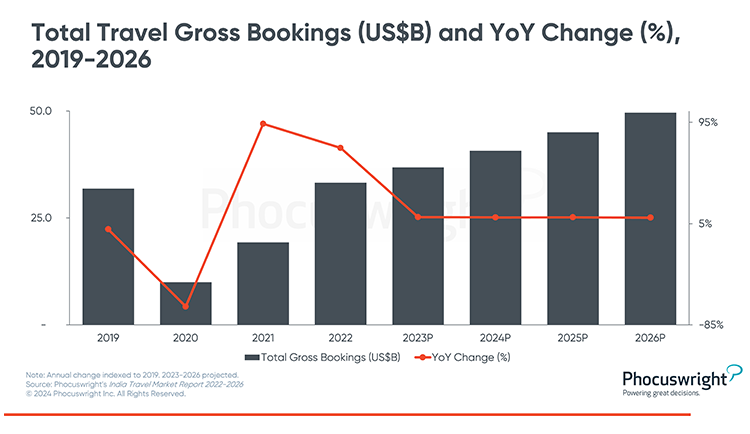Domestic tourism driving surge in India travel market
- Published:
- February 2024
- Analyst:
- Phocuswright Research
India continues to be one of the fastest growing major economies globally. India's GDP grew by 7.2% in the 2022-23 financial year, compared to a 9.1% rise in the previous fiscal year. Despite the war-induced disruptions in the energy and food sectors, alongside an unparalleled tightening of global monetary conditions aimed at mitigating decades-high inflation, India's economic growth remains robust. This has been driven by a public capital expenditure push and resilient domestic demand. The International Monetary Fund (IMF) has forecasted a growth of 6.3% in both FY24 and FY25.
After nearly collapsing due to pandemic-related shutdowns and restrictions in 2020 and 2021, India's travel market witnessed a strong rebound in 2022. According to Phocuswright’s travel research report India Travel Market Report 2022-2026, total travel gross bookings increased by 72% to $33.2 billion (see figure below).
Indian travelers, especially the younger generations, perceive travel not merely as a recreational pursuit but as an integral part of their lifestyle. Middle class expansion, coupled with growing disposable incomes and a paradigm shift in cultural perspectives, have catalyzed a surge in tourism in recent years. Moreover, the aftermath of the pandemic has fueled an increased inclination to travel, as people seek new experiences and a break from their routines, contributing to the industry's resilience and adaptability.
Domestic tourism constitutes the lion's share of the Indian travel industry and drove its revival from the pandemic lows. From the serene Himalayan landscapes to the vibrant coastal regions, Indians increasingly explored the cultural and geographical richness within the national borders, providing a significant impetus to the domestic travel sector.
India continues to be one of the fastest growing major economies globally. After nearly collapsing due to COVID-related shutdowns and restrictions in 2020 and 2021, India’s travel market witnessed a strong rebound in 2022. Gross bookings for the India travel market grew 72% to $33.2 billion in 2022, ultimately surpassing pre-pandemic totals, and double-digit gains were projected for 2023 as well. While travel gross bookings are not even across all segments, online penetration continues to climb. Sustained growth is anticipated through the rest of the forecast period.
Phocuswright’s India Travel Market Report 2022-2026 provides a comprehensive view of the India travel market, including detailed market sizing and projections, distribution trends, analysis of major travel segments, key developments and more.
This report is part of the Asia Pacific Travel Market Report 2022-2026 series, which includes all of the following publications (available now or publishing soon):
- Asia Pacific Travel Market Report 2022-2026
- Australia-New Zealand Travel Market Report 2022-2026
- China Travel Market Report 2022-2026
- India Travel Market Report 2022-2026
- Japan Travel Market Report 2022-2026
- Southeast Asia Travel Market Report 2022-2026
- Northeast Asia Travel Market Report 2022-2026
- Asia Pacific Travel Market Data Sheet 2022-2026
Research is our priority. Our Open Access research subscription puts the world’s most comprehensive library of travel research and data visualization at your fingertips.
Clients have relied on Phocuswright's deep industry knowledge for over 25 years to power great decisions, help justify a pitch, build a strategic plan and elevate any presentation through trusted research and data. When companies and executives reference Phocuswright, they gain the trust of an industry keen on data, trends and analytics.
See the full benefits of an Open Access subscription here.
Plus, we just redesigned Phocal Point, the powerful data visualization tool that now makes it easier to access and interpret Phocuswright data.
It's all about the data. With an updated navigation interface, new dynamic filtering, additional segment and channel breakouts in select markets and rich detailed views of 35+ markets, Phocal Point allows you to create custom interactive charts and view travel data by segment, channel, device, region and country. Our proprietary travel industry market sizing data allows you to look to the future with projections through 2026, and review historical data as far back as 2009.








.png)
.jpg)


